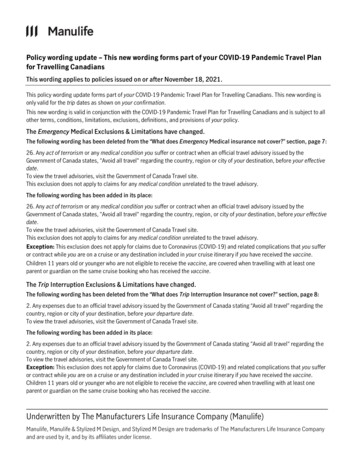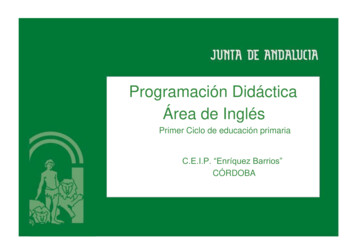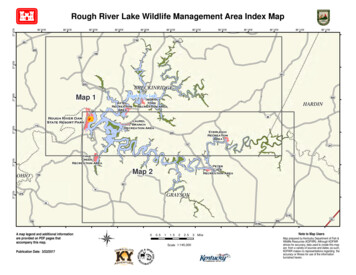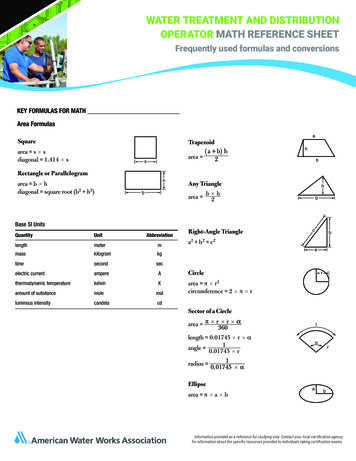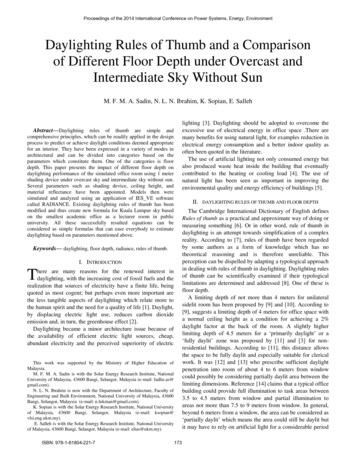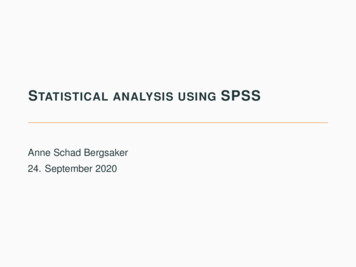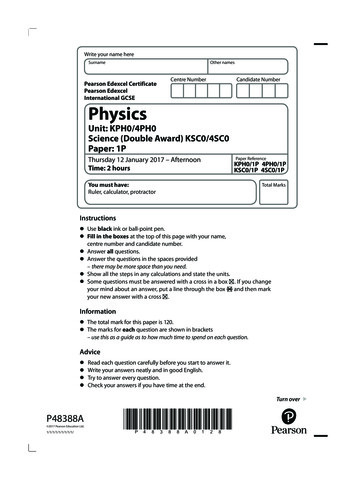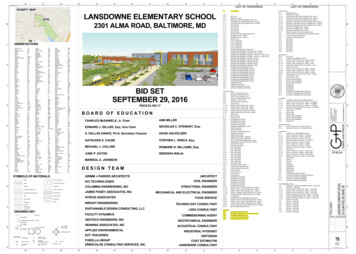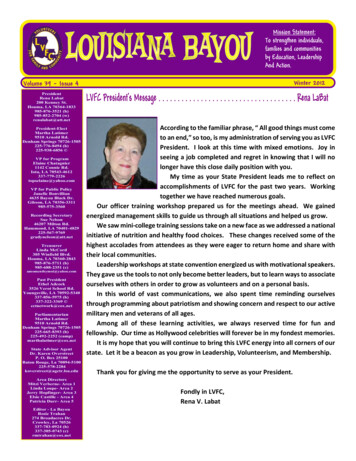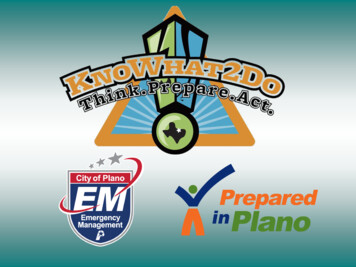
Transcription
Know Your AreaKNOW YOUR AREA (Jan. 2016)Collin County North Central Texas Region Population – 6.9 million Size – 12,800 square miles Geography – centered over theDallas/Ft. Worth Metroplex andincludes16 counties:– Collin, Dallas, Denton, Ellis, Erath,Hood, Hunt, Johnson, Kaufman,Navarro, Palo Pinto, Parker, Wise,Rockwall, Somervell, and Tarrant Population – 897,510 people(Plano 274,960)Size – 841 square miles(Plano 72 square miles)
WATCHES VS. WARNINGSWhat’s the difference?Watch: Conditions are favorable for the weather eventin or near the watch area. When a watch is announced,stay alert and be ready to take action.Warning: Weather event is imminent or occurring inthe warned area. Take action based on the emergencyat hand.
EMERGENCY WARNINGSYSTEMSStaying InformedTV/Radio BroadcastsNOAA All Hazards Weather RadioOutdoor Warning SystemsEmergency Alert SystemHighway MessagingPlano CityCallWireless Emergency Alerts (NEW)
OUTDOOR WARNING SIRENSIn Plano. NWS Issued Severe Thunderstorm Warningwith winds forecast over 70 mph NWS Issued Tornado Warning, namingPlano Hail of 1 1/2” or greater (ping pong ball orlarger) Confirmed sighting of a tornadoPlano has 13 sirens at this time and 3 morescheduled to be installed.
SEVERE THUNDERSTORM& LIGHTNINGThunderstorm Facts In North Central Texas, most severethunderstorms happen in the afternoon The typical thunderstorm is 15 miles indiameter and lasts an average of 30 minutesIn North Central Texas, from 2007 to 2016 18 Tornadoes Per Year 279 Severe Thunderstorm Events Per Year 55 Flash Flood Events Per Year
SEVERE THUNDERSTORM& LIGHTNINGSafety TipsIf you can hear thunder, you’re close enough to be struck by lightningMove to a sturdy building and stay away from the windows, if sturdy shelter isnot available, get inside a hardtop vehicle and keep windows upGet out of boats and away from waterUnplug appliances and avoid using land line telephones except in anemergency
TORNADOWhen a Tornado Watch or Warning has been issued,look out forDark, often greenish skyWall cloud/Supercell (a heavy,lowering cloud that is rain-free andmay begin to rotate)Large hailLoud roar; similar to a freight trainHave your 72 Hour Kit ready
TORNADOSAFETY TIPSEFNumberWindGust (mph)Stay away from the windows065-85Don’t try to outrun a tornado in yourcar186-1102111-135Advance warning is not alwayspossible3136-1654166-200Move to an interior room or hallway onthe lowest floor and get under a sturdypiece of furniture5Over 200Seek shelterEnhanced Fujita Scale
FLOODING & FLASH FLOODS 6 inches of fast moving water canknock over an adult 2 feet of water can carry away mostvehiclesMore people die from Flooding than any other severe-weather related hazard
WINTER WEATHERSAFETY TIPSWear several layers of loose-fitting, lightweight, warmclothingEnsure that your heating source is workingEnsure the wellbeing of your animalsAvoid driving on overpasses and bridgesWinterize your carWinterize your pipesBlack Ice is caused by extremely cold rain droplets thatform a film of clear ice on roadways. It’s hard to see andextremely slick, so look out for this hazard when thetemperature drops near freezing!
EXTREME HEAT,DROUGHT & WILDFIREHot Stuff, Get the FactsBetween 2004 and 2013, an average of 175 heatrelated deaths occurred in the U.S. each yearOlder adults, young children, and those who aresick or overweight are most likely to suffer whenthe mercury rises.
EXTREME HEAT,DROUGHT & WILDFIRESAFETY TIPSAt HomeOutdoorsStay out of the sunAdhere to local water restrictionsStay hydratedRespect “no burn” daysWeather strip doors and sillsDispose of cigarettes responsiblyInstall window air-conditionerssnuglyDispose of hot charcoal in a non-flammablecontainer or hose down before dumping
TERRORISMSee Something Say SomethingDevelop a disaster plan and ready youremergency supply kitCheck on school emergency plans forschool-aged childrenIdentify an internal room where you canblock out contaminated airFollow directions from officialsStay alert and informed at all times
TRANSPORTATION OFHAZARDOUS MATERIALSAll types of chemicals are rolling downour highways and railroads. Most get totheir destinations; but, accidents happen.Safety TipsStay aware of your surroundingsPrepare to use your senses to help youFollow directions from officials
HOUSEHOLD CHEMICALSPrevent home chemical emergenciesProperly dispose chemicals you do not needStore chemicals safelyAvoid mixing household chemicalsNever smoke while using household chemicalsAlways use chemicals in well-ventilated areasKnow the Poison Control number: 1-800-222-1222Most chemical accidents occur in homesand can be prevented!
PERSONAL SAFETY PLANKnow how toturn off utilities Include communications steps– Designate contacts Know what plans exist whereyour family members are: school,retirement homes, work Practice your planKnow how to operate fireextinguishersEnsure adequate insurancecoverageBlank wallet cards for recording yourcommunications plan can be foundonline at www.READY.gov.
EMERGENCY SUPPLY KITRecommended ItemsDuct tapeWhistleLocal mapsBattery or hand crank radioCashWeather Radio Dust maskFoodFlashlight and extra batteriesFirst-aid kitWaterPlastic sheetingMoist towelettesGarbage bagsWrench or pliersManual can opener
EMERGENCY SUPPLY KITDon’t Forget Access & Functional Needsfor Family MembersPrescriptions & equipmentInfants and Small ChildrenPetsRemember: check and update your kit every year—test batteries,check expiration dates and update important documents.
VEHICLE EMERGENCYSUPPLY KITRecommended Daily ItemsFlashlightFirst-aid kitWhite distress flagTire repair kit, jumper cables, and flaresDuring an Emergency AddBottled water and non-perishable foodSeasonal supplies to combat weatherLocal maps
PERSONAL RESPONSIBILITYKnow the systems available and what actions to takeLocal Emergency Alert SystemsObtain a NOAA Weather RadioRegister for emergency alerts- In PlanoPlano.gov/2902/Emergency-WarningsSign up for City CallTake the “Prepare" actions discussedUse your knowledge
VideoSEVERE WEATHERSHELTERING GUIDELINESThe safest place to be isunderground or safe roomIf not available, seek a smallwindowless interior room or hallwayon the lowest level of a structureMobile homes and vehicles shouldbe abandoned for sturdy shelterHighway overpasses are inadequate tornado sheltering areas.
SHELTERING-IN-PLACEVS. EVACUATIONWatch TV, listen to the radio or check the internet for official news &instructionsSheltering-In-PlaceEvacuateHazardous MaterialsLarge gas leaksBiological contaminantsDamaged structureSevere WeatherTake your pets with youDepending on your circumstances and nature of the disaster, the firstimportant decision is whether to shelter in place or evacuate.
SEVERE WEATHERSHELTERING GUIDELINES If stuck outdoors with no options for shelter Immediately get into avehicle, buckle your seat belt and try to drive to the closest sturdyshelter. If flying debris occurs while you are driving, pull over and park. Thefollowing options are a last resort: Stay in the car with the seat belt on. Put your head down below thewindows, covering with your hands and a blanket if possible. If you can safely get noticeably lower than the level of theroadway, exit your car and lie in that area, covering your head withyour hands. Your choice should be driven by your specific circumstances
DISASTER RECOVERYRecommended ActionsSafety firstBe alert, the event may cause new safety issuesCall your insurance agent and take pictures ofdamagesKeep good records of repair and cleaning costsUse the phone only for life-threateningemergencies 9-1-1 is for emergency response onlySeek disaster recovery assistanceif neededRECOVERY TAKES TIME
VOLUNTEER SERVICECity of Plano Volunteer Opportunities Community Emergency Response Team (CERT) Citizens Police Academy Citizens Fire Academy
City of PlanoDepartment of Emergency Management972-769-4824DEM@plano.govPreparedness is a community effort, so KnoWhat2Do!
Collin County Population . Citizens Police Academy Citizens Fire Academy City of Plano Volunteer Opportunities . Preparedness is a community effort, so KnoWhat2Do! City of Plano Department of Emergency Management 972-769-4824 DEM@plano.gov.
